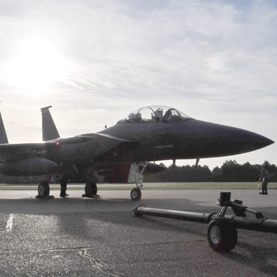
"Fatted Eagle" Joins "Green Hornet" in U.S. Military's Alternative Fuels Fighter Fleet
Oct 25, 2010 - David Biello - scientificamerican.com
The F-15 Eagle is the latest jet fighter to receive the alternative fuels treatment, flying October 22 on a 50-
 |
| FLYING ON TALLOW: An F-15 fighter jet, like the one pictured here, flew on a blend of regular jet fuel and fuel derived from beef tallow on October 22. Image: U.S. Air Force photo/Senior Airman David Dobrydney |
50 blend of conventional jet fuel and an alternative—in this case made from specially processed animal fat: beef tallow bio-jet fuel.
Already, nearly the entire fleet of 40-plus aircraft flown by the U.S. Air Force has been certified to fly on jet fuels made from natural gas or coal—the exceptions being the drone aircraft that have been too busy abroad to be tested at home. The goal: "by 2016, to be able to replace up to half of the fuel used Air Force wide with an alternative blend that was both cost-competitive and had no worse greenhouse gas footprint than petroleum products," says Jeff Braun, chief of the Air Force's alternative fuels certification division.
Nor is the U.S. Air Force alone in this effort. The U.S. Navy has flown its F-18 Hornet on jet fuel derived from the oil seeds of the camelina plant—a weedy flower related to mustard. And the U.S. Army hopes to turn its trash into fuel in an effort to cut down on vulnerable supply lines. "This effort is very harmonized with not only other services but also commercial airlines," Braun says. "As much fuel as we burn, we only represent a small commercial airline."
The new fuels perform as well or better than conventional fuel in terms of energy density and other metrics, though they lack the aromatic compounds of conventionally derived kerosene. The aromatics in petroleum-derived kerosene help swell shut seals in conventional engines and the bio-jet fuel's lack of them, among other things, necessitates blending with conventional jet fuel. Nevertheless, the alternative jet fuels are fully interchangeable in fueling infrastructure, according to Betty Rodriguez, chief engineer of the Air Force's alternative fuels certification division.
In fact, the problem with the U.S. military's efforts seems not to be the alternative fuels themselves but rather the production of such fuels from oils and crops in the volume necessary to replace a fraction of the 800 million gallons consumed by the U.S. Air Force alone. "We don't have control over whether people are going to grow camelina," says chemical engineer Tim Edwards of the Air Force's research lab. "Asking for 1,000 gallons of fuel scares people off."
Plus, biofuels come with their own issues, such as displacing food crops. And turning animal feed into cow fat and then turning that beef tallow into a jet fuel is an energy-inefficient process; it takes roughly three kilograms of feed for a cow to gain less than half a kilogram in weight.
Regardless, the Air Force has already requisitioned roughly 40,000 gallons of the bio-jet fuel (known as hydrotreated renewable jet or HRJ) as well as 700,000 gallons of fuels derived by the Fischer-Tropsch process from natural gas or coal. The ongoing testing of the HRJ will require flights in an F-22 and a Global Hawk, to test the fuel's ability to withstand both the hot flying of a fighter jet and the long, cold sorties at 60,000 feet favored by unmanned aircraft. Not to be outdone, the Navy tested on October 22 a boat fueled by a blend of conventional diesel as well as "Green Diesel" made from oil derived from algae such as the boat might otherwise plow through.

|

